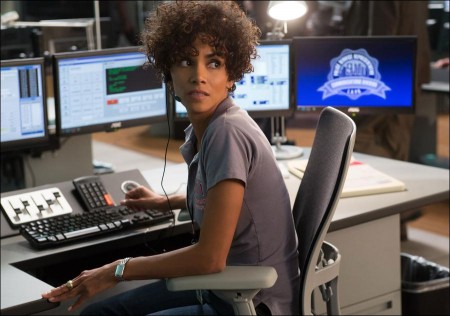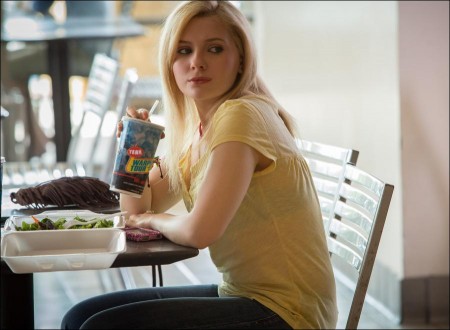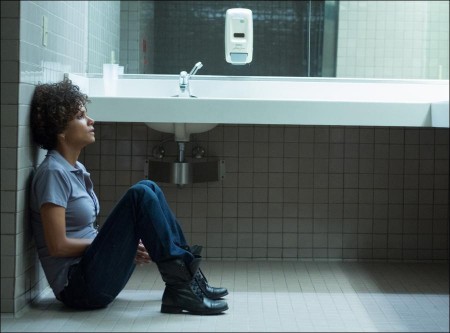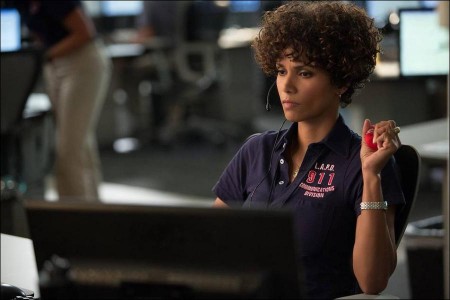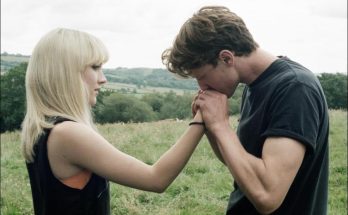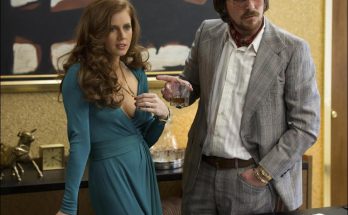Taglines: There are 188 million 911 calls a year. This one made it personal.
Veteran 911 Emergency Call Center operator Jordan (Halle Berry) has the kind of job that’s not for the faint of heart: navigating the public’s distress in order to save lives. But when a young woman’s frantic report of a prowler ends tragically, Jordan is devastated. Reassessing her life, Jordan wonders if perhaps she’s experienced her last fraught-filled phone call.
With a supportive cop (Morris Chestnut) for a boyfriend, maybe it’s time to step back, enjoy life, and teach others the ins and outs of her high-pressure profession. That lifeline to strangers isn’t over yet, though. When average American teenager Casey (Abigail Breslin), is abducted by a serial killer (Michael Eklund), she manages to place a 911 call from the trunk of the killer’s car.
Jordan, leading a group of new recruits through the massive Call Center operation, is in earshot of the call. It’s an all-too familiar scenario for this experienced public servant, but before long, Casey’s situation reveals itself as eerily, shockingly familiar. There’s only one thing Jordan can do: take charge in a way she’s never done before. She must turn Casey into a partner in helping them track down the killer, and prove that this call is Jordan’s calling.
The Call is an American crime thriller film directed by Brad Anderson and written by Richard D’Ovidio. The film stars Abigail Breslin as Casey Welson, a teenage girl kidnapped by a serial killer and Halle Berry as Jordan Turner, the 9-1-1 operator who receives her call. Morris Chestnut, Michael Eklund, Michael Imperioli, and David Otunga also star. The story was originally envisioned as a television series, but D’Ovidio later rewrote it as a 94-minute feature film. Filming began in July 2012 and spanned a period of 25 days, with all scenes being shot in Los Angeles, mainly Burbank and Santa Clarita.
Placing The Call (2013)
Central to the effectiveness of The Call is its twofold realism: the experience Casey goes through, and the verisimilitude of the call center where Jordan works. Of the kidnapping scenes with Breslin, director Brad Anderson explains, “We literally shot her scenes in the trunk of cars, so we were able to bring the audience into her space and feel her claustrophobia and fear.”
Producer Jeff Graup says, “The abduction is in real time, so we wanted it to be as real as possible, so the audience won’t be taken out of the movie. We really wanted to have edge and grit to it, where the audience is feeling what Casey’s feeling, which is impending doom. Brad is the perfect guy to get that mood out, because this journey is one where you want the audience to feel as uncomfortable as we were reading the script.”
To that end, trunk sets were designed with removable pieces so cameras could be put where needed. A special probe lens was used so an even greater level of claustrophobic intimacy could be achieved. With realism the operative word during the shoot, Anderson aimed for a loose, hand-held style. “I’m not locking down the camera. I’m allowing the action to drive the camera as opposed to vice versa, and keeping everything spontaneous-feeling.
I guess documentary-style would be the simplest way to describe the look. We’re also shooting everything with a certain shutter speed that gives it a very kinetic feel, since eighty percent of the story, from the point where Abby’s character is abducted, to the end, is just a continuum of amped-up suspense and drama. It just spirals into craziness, so we’re trying to keep the look to match that.”
With regards to the depiction of the Emergency Call Center, a busy, console-filled room called the Hive in the film, authenticity was a high priority. The filmmakers made several visits to two Los Angeles Emergency Call Centers. Says producer Bradley Gallo, “We all spent a tremendous amount of time there to make sure we got the technical aspects correct.”
On capturing the real vibe of a call center, producer Jeff Graup says, “The way the 911 Center was portrayed was very important to us. A call center has never been seen on film. Everyone has either called 911 or knows someone who has, but no one really knows what it looks like or the process. We wanted to make sure that the entire set accurately reflects everything that goes on, from the calm to the stress.”
Production designer Franco-Giacomo Carbone (The Expendables) replicated the call center in an existing office space in Thousand Oaks, CA, which was big enough to build the entire set, including over 12 operator stations and a phalanx of monitors, as one would see in a real call center. Eighty extras were used to give human weight to the “buzziness” of the Hive.
The company Playback Technologies was also recruited to get the on-set video playback elements of a screen-filled control room right. Says Playback Technologies president Steve Irwin, “We have a crew of guys responsible for getting the right content on the monitors. And with this large number of monitors, we try to keep them all on, and the whole room up and operating like an actual 911 center. One of our areas of responsibility is to make sure that the Arriflex high-definition cameras are able to photograph all the monitors, so color temperature, color balance, exposure, whether monitors are going to flicker when they’re re-photographed, are all in control. We work with the director of photography to make sure everything looks as good as it can.”
Anderson addresses the importance of the Hive set in terms of the story’s emotional stakes. “It’s been a challenge trying to create the scale we need for these scenes. Much of [Halle’s] action is at a desk on a phone in front of a computer, but despite that, we wanted to set it in a location that, when you pull back, you realize the scope of it as opposed to just being an office space. The Hive we’ve created is as big as they tend to be, and has all the eye candy, as we like to say — monitors and jumbotrons and things that help create the sense of urgency. This is our biggest location, and we wanted to get all the details right.”
Not only did an actual 911 call center veteran consult on those details, the production used some real operators on the floor. “It’s all driving to try and create that authenticity, that realism,” says Anderson.
In the end, the filmmakers want The Call to entertain, with a story that not only pulses with excitement, but that resonates with themes of redemption and empowerment. Says producer Bradley Gallo, “Abigail’s character is a goody two-shoes who doesn’t really go outside the bounds of what you’re supposed to do, and she has to overcome that and stand up for herself, to the point where she has to take on a killer. That transformation is an awesome theme. And Halle is playing a character who loses a girl on a call, is tortured by it, and has to get redemption through another call.”
Screenwriter Richard D’Ovidio likes that the excitement of The Call is made more enriching by putting women front and center. “[Women] are always the ones being saved, and I like that the two of them save themselves and each other in the process, you know?” says D’Ovidio. “A lot of the 911 operators are women, and they’re tough, they’re strong, they’re composed, and it’s very impressive to watch.”
The Call (2013)
Directed by: Brad Anderson
Starring: Halle Berry, Abigail Breslin, Michael Imperioli, Morris Chestnut, Ella Rae Peck
Screenplay by: Richard D’Ovidio
Production Design by: Franco-Giacomo Carbone
Cinematography by: Tom Yatsko
Film Editing by: Avi Youabian
Costume Design by: Magali Guidasci
Set Decoration by: Robert Gould
Music by: John Debney
MPAA Rating: R for violence, disturbing content and some language.
Studio: Sony Pictures
Release Date: March 15, 2013
Visits: 81
